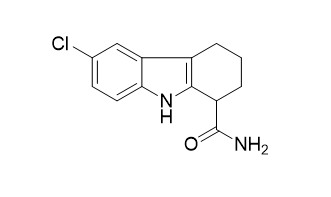Selisistat (EX 527)
Selisistat (EX 527, SEN0014196) is a potent and selective SIRT1 inhibitor with IC50 of 38 nM in a cell-free assay, exhibits >200-fold selectivity against SIRT2 and SIRT3.
Inquire / Order:
manager@chemfaces.com
Technical Inquiries:
service@chemfaces.com
Tel:
+86-27-84237783
Fax:
+86-27-84254680
Address:
1 Building, No. 83, CheCheng Rd., Wuhan Economic and Technological Development Zone, Wuhan, Hubei 430056, PRC
Providing storage is as stated on the product vial and the vial is kept tightly sealed, the product can be stored for up to
24 months(2-8C).
Wherever possible, you should prepare and use solutions on the same day. However, if you need to make up stock solutions in advance, we recommend that you store the solution as aliquots in tightly sealed vials at -20C. Generally, these will be useable for up to two weeks. Before use, and prior to opening the vial we recommend that you allow your product to equilibrate to room temperature for at least 1 hour.
Need more advice on solubility, usage and handling? Please email to: service@chemfaces.com
The packaging of the product may have turned upside down during transportation, resulting in the natural compounds adhering to the neck or cap of the vial. take the vial out of its packaging and gently shake to let the compounds fall to the bottom of the vial. for liquid products, centrifuge at 200-500 RPM to gather the liquid at the bottom of the vial. try to avoid loss or contamination during handling.
Crystals2020, 10(3), 206.
Biochem Biophys Res Commun.2020, 522(4):1052-1058
J Int Med Res.2021, 49(7):3000605211032849.
Cytotechnology2022, s10616
Molecules 2022, 27(3),1047.
Food Sci Biotechnol.2024, 33(15):3629-3637.
Evid Based Complement Alternat Med.2022, 2022:1307173.
Pharmaceuticals (Basel).2024, 17(8):1001.
Asian Journal of Chemistry2018, 30(12):2699-2703
Pharmacol Res.2022, 182:106346.
Related and Featured Products
J Biol Chem., 2009 Jul 3;284(27):18210-7.
SirT1 is an inhibitor of proliferation and tumor formation in colon cancer.[Pubmed:
19433578]
The NAD-dependent deacetylase SirT1 regulates factors involved in stress response and cell survival and is a potential drug target of activators and inhibitors. Determination of SirT1 function in tumor cells is important for its targeting in cancer therapy.
METHODS AND RESULTS:
We found that SirT1 knockdown by short hairpin RNA accelerates tumor xenograft formation by HCT116 cells, whereas SirT1 overexpression inhibits tumor formation. Furthermore, pharmacological inhibition of SirT1 stimulates cell proliferation under conditions of growth factor deprivation. Paradoxically, SirT1 inhibition also sensitizes cells to apoptosis by chemotherapy drugs. Immunohistochemical staining revealed high level SirT1 in normal colon mucosa and benign adenomas. SirT1 overexpression was observed in approximately 25% of stage I/II/III colorectal adenocarcinomas but rarely found in advanced stage IV tumors. Furthermore, approximately 30% of carcinomas showed lower than normal SirT1 expression. This pattern is consistent with SirT1 having pleiotropic effects during cancer development (anti-proliferation and anti-apoptotic).
CONCLUSIONS:
These results suggest a rationale for the use of SirT1 activators and inhibitors in the prevention and treatment of colon cancer.
Mol Cell Biol,2006 Jan;26(1):28-38.
Inhibition of SIRT1 catalytic activity increases p53 acetylation but does not alter cell survival following DNA damage.[Pubmed:
16354677]
293T cells are transiently transfected with GST-tagged human SIRT1 in the pDEST27 Gateway vector using FuGENE-6. After 48 hours, the cells are lysed with 50 mM Tris, pH 8.0, 120 mM NaCl, 1 mM EDTA, and 0.5% Nonidet P-40, supplemented with Complete Mini protease inhibitor cocktail tablets. GST-SIRT1 is purified from lysates using glutathione-Sepharose beads and washed extensively in the above buffer. The deacetylation assay is performed with approximately 30 ng of GST-SIRT1 in the presence of EX 527 (48 pM to 100 μM). Deacetylation is measured using the Fluor de Lys kit using a fluorogenic peptide encompassing residues 379 to 382 of p53, acetylated on lysine 382. The acetylated lysine residue is coupled to an aminomethylcoumarin moiety. The peptide is deacetylated by SIRT1, followed by the addition of a proteolytic developer that releases the fluorescent aminomethylcoumarin. Briefly, enzyme preparations are incubated with 170 μM NAD+ and 100 μM p53 fluorogenic peptide for 45 minutes at 37 °C followed by incubation in developer for 15 minutes at 37 °C. Fluorescence is measured by excitation at 360 nm and emission at 460 nm and enzymatic activity is expressed in relative fluorescence units.
Mol Cell Biol, 2006 Jan;26(1):28-38.
Inhibition of SIRT1 catalytic activity increases p53 acetylation but does not alter cell survival following DNA damage.[Pubmed:
16354677]
Cell lines:NCI-H460, MCF-7, U-2 OS and HMEC
Concentrations: Dissolved in DMSO, final concentration 1 μM
Incubation Time: 48 or 72 hours
Method:
For viability assays, cells are treated with EX 527 for 48 hours. Cell viability is then determined using the Cell Titer-Glo luminescent assay, which measures total ATP level as an index of cell number. Luminescence is measured on a Luminoskan Ascent. For the proliferation assay, 0.5 μCi/mL of [14C]thymidine is added to the medium immediately after EX 527. Plates are counted at 48 hours (HMEC) or 72 hours (NCI-H460, MCF-7, and U-2 OS cells) in a Microbeta liquid scintillation counter. Thymidine incorporated by the cells is detected by proximity to the scintillant in the base of the Cytostar-T tissue culture plate.
Diabetes,2011 Apr;60(4):1177-85.
The central Sirtuin 1/p53 pathway is essential for the orexigenic action of ghrelin.[Pubmed:
21386086]
Animal Models: Male Sprague-Dawley rats
Dosages: ~5 μg/rat
Administration: Intracerebroventricular injection



